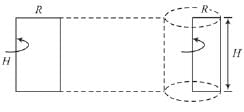Class 8 Exam > Class 8 Questions > A solid shape is generated by rotating a rect...
Start Learning for Free
A solid shape is generated by rotating a rectangle about any of its sides. The shape will be :
- a)Cuboid
- b)Cone
- c)Sphere
- d)Cylinder (right circular)
Correct answer is option 'D'. Can you explain this answer?
Verified Answer
A solid shape is generated by rotating a rectangle about any of its si...

Most Upvoted Answer
A solid shape is generated by rotating a rectangle about any of its si...
Explanation:
To understand why the correct answer is option 'D' (cylinder), let's break down the process of rotating a rectangle about its sides and examine the resulting shape.
Rotating a Rectangle:
When a rectangle is rotated about one of its sides, the resulting shape is a solid figure with a circular base and two parallel, congruent circular faces on either end. This figure is known as a cylinder.
Properties of a Cylinder:
A cylinder is a three-dimensional solid shape that has the following properties:
1. Bases: The two circular faces at the top and bottom of the cylinder are called bases. These bases are parallel and congruent.
2. Height: The height of the cylinder is the perpendicular distance between the two bases. It represents the distance between the top and bottom faces.
3. Lateral Surface: The curved surface of the cylinder that connects the two bases is called the lateral surface. It is formed by the rectangle being rotated.
4. Axis: The axis of a cylinder is a straight line passing through the center of both bases. It is also the line about which the rectangle was rotated.
5. Volume: The volume of a cylinder can be calculated using the formula V = πr^2h, where r is the radius of the base and h is the height of the cylinder.
6. Surface Area: The surface area of a cylinder can be calculated using the formula A = 2πrh + 2πr^2, where r is the radius of the base and h is the height of the cylinder.
Conclusion:
By rotating a rectangle about any of its sides, we obtain a solid shape known as a cylinder. The cylinder has circular bases, a curved lateral surface, and a straight axis passing through the center of the bases. The volume and surface area of a cylinder can be calculated using specific formulas.
To understand why the correct answer is option 'D' (cylinder), let's break down the process of rotating a rectangle about its sides and examine the resulting shape.
Rotating a Rectangle:
When a rectangle is rotated about one of its sides, the resulting shape is a solid figure with a circular base and two parallel, congruent circular faces on either end. This figure is known as a cylinder.
Properties of a Cylinder:
A cylinder is a three-dimensional solid shape that has the following properties:
1. Bases: The two circular faces at the top and bottom of the cylinder are called bases. These bases are parallel and congruent.
2. Height: The height of the cylinder is the perpendicular distance between the two bases. It represents the distance between the top and bottom faces.
3. Lateral Surface: The curved surface of the cylinder that connects the two bases is called the lateral surface. It is formed by the rectangle being rotated.
4. Axis: The axis of a cylinder is a straight line passing through the center of both bases. It is also the line about which the rectangle was rotated.
5. Volume: The volume of a cylinder can be calculated using the formula V = πr^2h, where r is the radius of the base and h is the height of the cylinder.
6. Surface Area: The surface area of a cylinder can be calculated using the formula A = 2πrh + 2πr^2, where r is the radius of the base and h is the height of the cylinder.
Conclusion:
By rotating a rectangle about any of its sides, we obtain a solid shape known as a cylinder. The cylinder has circular bases, a curved lateral surface, and a straight axis passing through the center of the bases. The volume and surface area of a cylinder can be calculated using specific formulas.

|
Explore Courses for Class 8 exam
|

|
Question Description
A solid shape is generated by rotating a rectangle about any of its sides. The shape will be :a)Cuboidb)Conec)Sphered)Cylinder (right circular)Correct answer is option 'D'. Can you explain this answer? for Class 8 2025 is part of Class 8 preparation. The Question and answers have been prepared according to the Class 8 exam syllabus. Information about A solid shape is generated by rotating a rectangle about any of its sides. The shape will be :a)Cuboidb)Conec)Sphered)Cylinder (right circular)Correct answer is option 'D'. Can you explain this answer? covers all topics & solutions for Class 8 2025 Exam. Find important definitions, questions, meanings, examples, exercises and tests below for A solid shape is generated by rotating a rectangle about any of its sides. The shape will be :a)Cuboidb)Conec)Sphered)Cylinder (right circular)Correct answer is option 'D'. Can you explain this answer?.
A solid shape is generated by rotating a rectangle about any of its sides. The shape will be :a)Cuboidb)Conec)Sphered)Cylinder (right circular)Correct answer is option 'D'. Can you explain this answer? for Class 8 2025 is part of Class 8 preparation. The Question and answers have been prepared according to the Class 8 exam syllabus. Information about A solid shape is generated by rotating a rectangle about any of its sides. The shape will be :a)Cuboidb)Conec)Sphered)Cylinder (right circular)Correct answer is option 'D'. Can you explain this answer? covers all topics & solutions for Class 8 2025 Exam. Find important definitions, questions, meanings, examples, exercises and tests below for A solid shape is generated by rotating a rectangle about any of its sides. The shape will be :a)Cuboidb)Conec)Sphered)Cylinder (right circular)Correct answer is option 'D'. Can you explain this answer?.
Solutions for A solid shape is generated by rotating a rectangle about any of its sides. The shape will be :a)Cuboidb)Conec)Sphered)Cylinder (right circular)Correct answer is option 'D'. Can you explain this answer? in English & in Hindi are available as part of our courses for Class 8.
Download more important topics, notes, lectures and mock test series for Class 8 Exam by signing up for free.
Here you can find the meaning of A solid shape is generated by rotating a rectangle about any of its sides. The shape will be :a)Cuboidb)Conec)Sphered)Cylinder (right circular)Correct answer is option 'D'. Can you explain this answer? defined & explained in the simplest way possible. Besides giving the explanation of
A solid shape is generated by rotating a rectangle about any of its sides. The shape will be :a)Cuboidb)Conec)Sphered)Cylinder (right circular)Correct answer is option 'D'. Can you explain this answer?, a detailed solution for A solid shape is generated by rotating a rectangle about any of its sides. The shape will be :a)Cuboidb)Conec)Sphered)Cylinder (right circular)Correct answer is option 'D'. Can you explain this answer? has been provided alongside types of A solid shape is generated by rotating a rectangle about any of its sides. The shape will be :a)Cuboidb)Conec)Sphered)Cylinder (right circular)Correct answer is option 'D'. Can you explain this answer? theory, EduRev gives you an
ample number of questions to practice A solid shape is generated by rotating a rectangle about any of its sides. The shape will be :a)Cuboidb)Conec)Sphered)Cylinder (right circular)Correct answer is option 'D'. Can you explain this answer? tests, examples and also practice Class 8 tests.

|
Explore Courses for Class 8 exam
|

|
Signup for Free!
Signup to see your scores go up within 7 days! Learn & Practice with 1000+ FREE Notes, Videos & Tests.


















